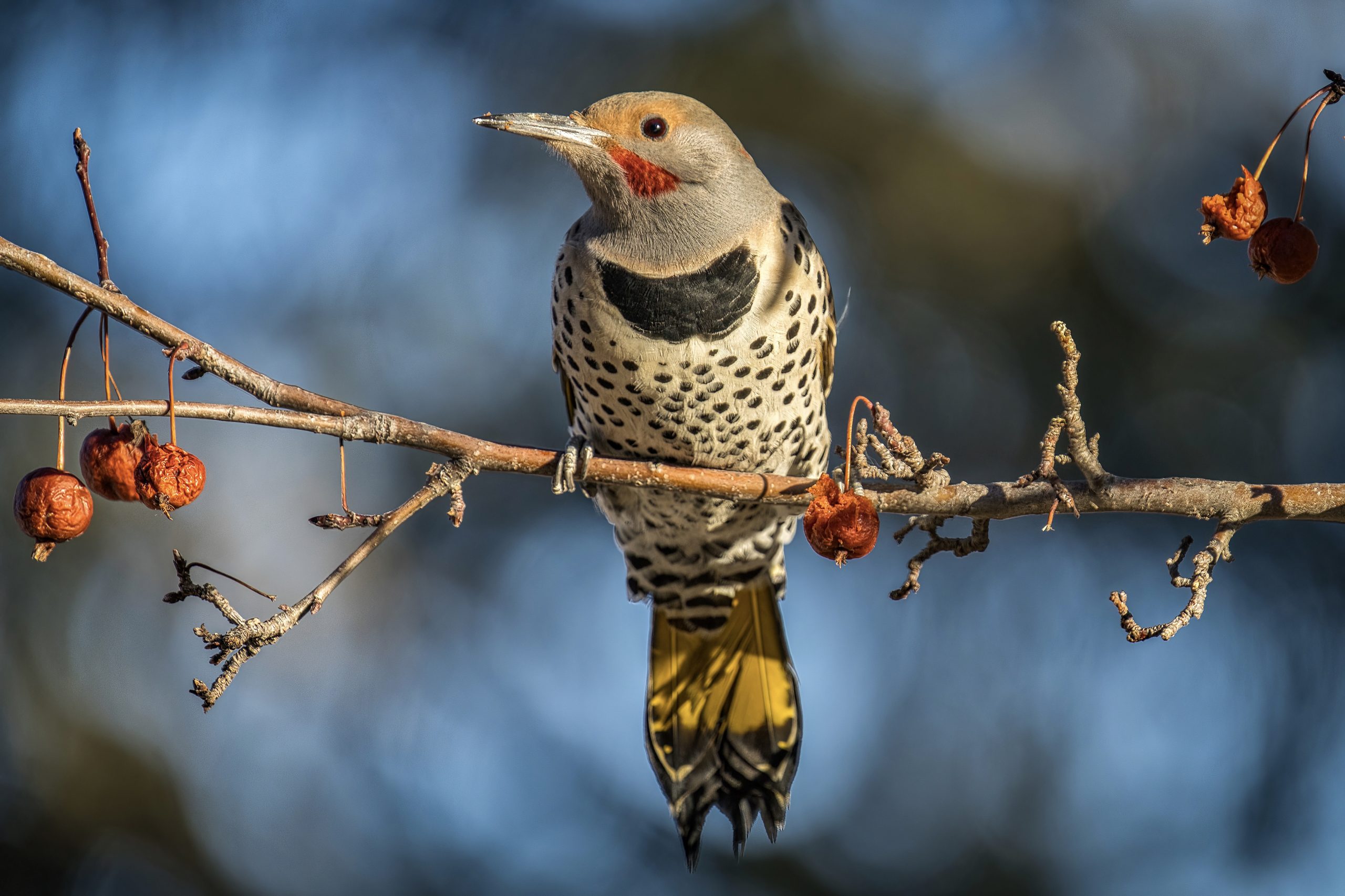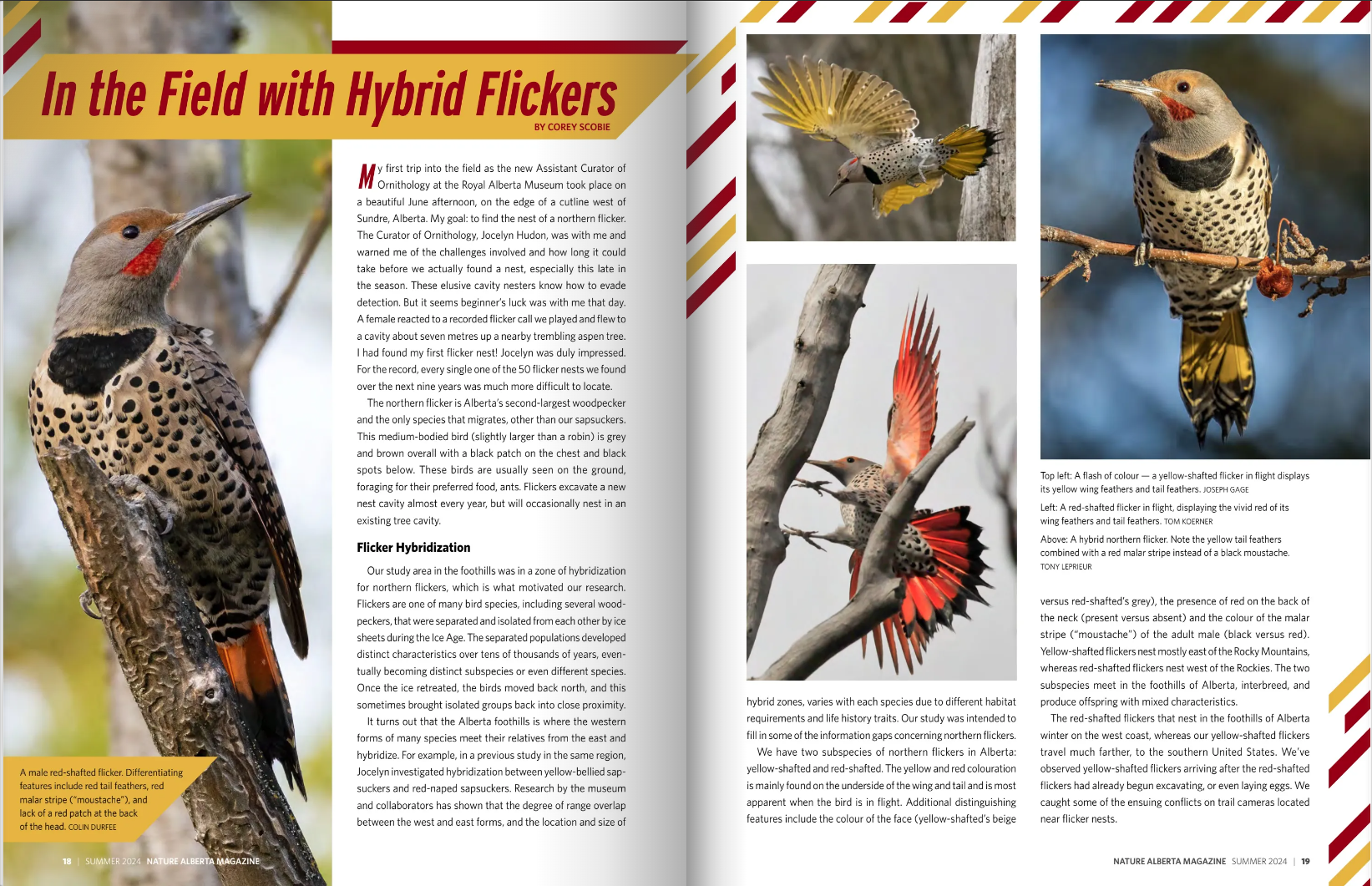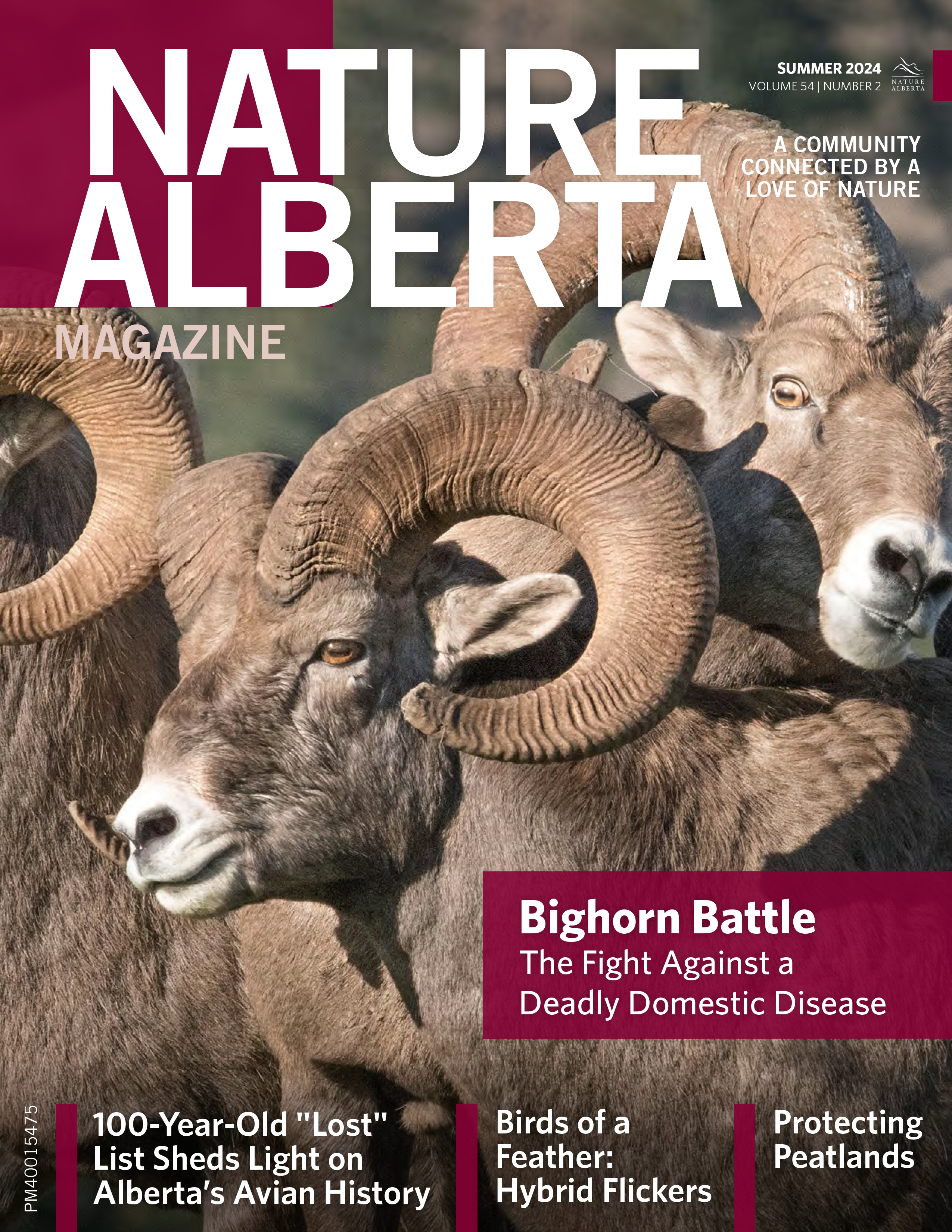In the Field with Hybrid Flickers
5 July 2024

BY COREY SCOBIE
My first trip into the field as the new Assistant Curator of Ornithology at the Royal Alberta Museum took place on a beautiful June afternoon, on the edge of a cutline west of Sundre, Alberta. My goal: to find the nest of a northern flicker. The Curator of Ornithology, Jocelyn Hudon, was with me and warned me of the challenges involved and how long it could take before we actually found a nest, especially this late in the season. These elusive cavity nesters know how to evade detection. But it seems beginner’s luck was with me that day. A female reacted to a recorded flicker call we played and flew to a cavity about seven metres up a nearby trembling aspen tree. I had found my first flicker nest! Jocelyn was duly impressed. For the record, every single one of the 50 flicker nests we found over the next nine years were much more difficult to locate.
The northern flicker is Alberta’s second-largest woodpecker and the only species that migrates, other than our sapsuckers. This medium-bodied bird (slightly larger than a robin) is grey and brown overall with a black patch on the chest and black spots below. These birds are usually seen on the ground, foraging for their preferred food, ants. Flickers excavate a new nest cavity almost every year, but will occasionally nest in an existing tree cavity.
Flicker Hybridization
Our study area in the foothills was in a zone of hybridization for northern flickers, which is what motivated our research. Flickers are one of many bird species, including several woodpeckers, that were separated and isolated from each other by ice sheets during the Ice Age. The separated populations developed distinct characteristics over tens of thousands of years, eventually becoming distinct subspecies or even different species. Once the ice retreated, the birds moved back north, and this sometimes brought isolated groups back into close proximity.
It turns out that the Alberta foothills is where the western forms of many species meet their relatives from the east and hybridize. For example, in a previous study in the same region, Jocelyn investigated hybridization between yellow-bellied sapsuckers and red-naped sapsuckers. Research by the museum and collaborators has shown that the degree of range overlap between the west and east forms, and the location and size of hybrid zones, varies with each species due to different habitat requirements and life history traits. Our study was intended to fill in some of the information gaps concerning northern flickers.
We have two subspecies of northern flickers in Alberta: yellow-shafted and red-shafted. The yellow and red colouration is mainly found on the underside of the wing and tail and is most apparent when the bird is in flight. Additional distinguishing features include the colour of the face (yellow-shafted’s beige versus red-shafted’s grey), the presence of red on the back of the neck (present versus absent) and the colour of the malar stripe (“moustache”) of the adult male (black versus red). Yellow-shafted flickers nest mostly east of the Rocky Mountains, whereas red-shafted flickers nest west of the Rockies. The two subspecies meet in the foothills of Alberta, interbreed, and produce offspring with mixed characteristics.
The red-shafted flickers that nest in the foothills of Alberta winter on the west coast, whereas our yellow-shafted flickers travel much farther, to the southern United States. We’ve observed yellow-shafted flickers arriving after the red-shafted flickers had already begun excavating, or even laying eggs. We caught some of the ensuing conflicts on trail cameras located near flicker nests.
Field Studies
Our field research involved nest surveys, investigations of nesting success, and bird banding. Nest surveys were conducted in early May, when flickers are noisily drumming, calling, and excavating their nest cavities. Whenever we found a potential nest, we would attach a wireless camera to the end of a fibreglass pole and peer inside the cavity to determine if eggs or nestlings were present. If the nest was active, we would install a trail camera on an adjacent tree to monitor for nest predation and other activities. We returned to active nests several times to monitor the egg-laying process. This allowed us to estimate when the chicks would hatch and when the young would fledge. With this information we could plan the timing of subsequent studies that involved capturing the adults and young.
Flickers are less sensitive to disturbance after their eggs have been laid, so our live captures were not conducted until after egg laying was complete. All precautions were taken to ensure our disturbance at the nest was minimal and we were always in possession of all required permits. To capture adults, we attached a wire-framed net to a hinge above the nest cavity. The net was held above the nest cavity by a fishing line that led to a release mechanism on the ground. When an adult entered the cavity, we waited for an hour to allow it to warm the eggs and then activated the net, closing off the entrance. The adults would typically fly out of the cavity and into the net as we climbed the tree to retrieve the captured bird. Banding the fledglings was more challenging. To do this we had to cut a door into the tree, just above the eggs, permitting direct access to the nest.
Each flicker we banded was weighed, measured, and photographed. In addition, we scored the colour of the feathers and took a sample of blood and a feather. When we were done, we released the adult at the base of the nest tree and reset the trap above the nest cavity to capture the other adult. Before we left the area, we observed the nest cavity at a distance until we confirmed that one adult returned and was inside the cavity. After all the banding was completed, the trap was removed and the cut door was securely returned to the tree and sealed with silicone. This was an exciting process and allowed us unprecedented access to this cavity nester.
Research Findings
In total, we banded 39 adults and 77 young, and the study of these banded birds generated several insights. Three flickers we banded as adults returned in subsequent years to nest near where they were originally banded, though with a different mate. Other birds we banded were sighted in more distant locations. One bird (from the first nest I found) was resighted two years later near Priddis, Alberta and another was spotted in Platte City, Montana ten months after it was banded. Both of these resightings came from east of the Rocky Mountains, which suggests that hybrid flickers may follow the yellow-shafted flicker migration pattern. However, it’s too early to be confident about this. An alternative explanation is that there is more intensive monitoring in the east compared with the west (where the red-shafted flicker overwinters). Fortunately, northern flickers live up to eight years in the wild, so there is still time for the flickers we banded to be resighted, providing additional insight into hybrid flicker migration patterns.
Over the last eight years, we located 50 flicker nests in the hybrid zone, which has helped shed light on nest success. We found that northern flicker nests occur in very low densities in the foothills, and apparent nest survival is lower than similar studies using the same methods in other locations. Sixty percent of the northern flicker nests we monitored were successful. The two most common causes of nest failures were death of one of the parents and nest predation by red squirrels (each accounting for approximately one-quarter of the known nest failures). Two nests failed when water entered the cavity through the entrance while it was raining or snowing. Many other nest failures occurred soon after severe weather (late snowstorm, continuous rain, etc.), but we were unable to determine the specific cause. Statistical analysis is now underway and will help quantify the significance of these factors. We will also examine whether the type of clearing near the nest (natural versus forestry cut block) has an effect on nest success.
Another interesting discovery we made was that nestling hybrids have complex colouration patterns. Rather than being simply intermediate between the two parents, they exhibit a diversity not seen in either adult. For example, we’ve had several nests where both adults had very little red on the back of their necks, but the nestlings varied from very faint markings to big patches of red feathers (typical of pure yellow-shafted flickers). We also saw interesting variations in the malar stripe (“moustache”) in male hybrids. In some birds, the front half of the stripe (closest to the bill) was red and the back half was black, in others the top half of the stripe was red and the bottom half was black, and in some the base of all the feathers were black and the tops were red. Normally, yellow-shafted flickers have a solid black malar stripe whereas red-shafted have a solid red stripe. Clearly, these traits are under complex genetic control.
As a side note, our search for woodpecker nests in the foothills revealed many species other than flickers living inside woodpecker cavities. Over the years, we found red squirrels, northern flying squirrels, boreal owls, northern saw-whet owls, American kestrels, and mountain bluebirds among other species in these cavities. This shows the important ecological role that woodpeckers play in supporting forest biodiversity.
Alberta’s foothills are a great place to see not only hybrid woodpeckers but hybrids of numerous other bird species. Although the hybrid flickers are rooted in the foothills, you don’t need to venture far to find regular flickers, as these woodpeckers can be found throughout Alberta wherever there are big trees and open grassland with lots of ants. The next time you find yourself in flicker habitat, keep your eyes open for that flash of yellow or red underwing as they take flight, then look up. If luck is with you, maybe you’ll find yourself staring up at a flicker cavity!
Corey Scobie is the Assistant Curator of Ornithology at the Royal Alberta Museum, where he prepares birds, helps manage the ornithology collection, and assists with various research projects. Previously, he worked with species at risk in the grasslands of Alberta and Saskatchewan, where he focused on the influence of artificial sound on burrowing owls.
Read the Original Article for this Post
For a richer reading experience, view this article in the professionally designed online magazine with all images and graphs in place.
This article originally ran in the Summer 2024 issue of Nature Alberta Magazine (Vol. 54 | No. 2).


